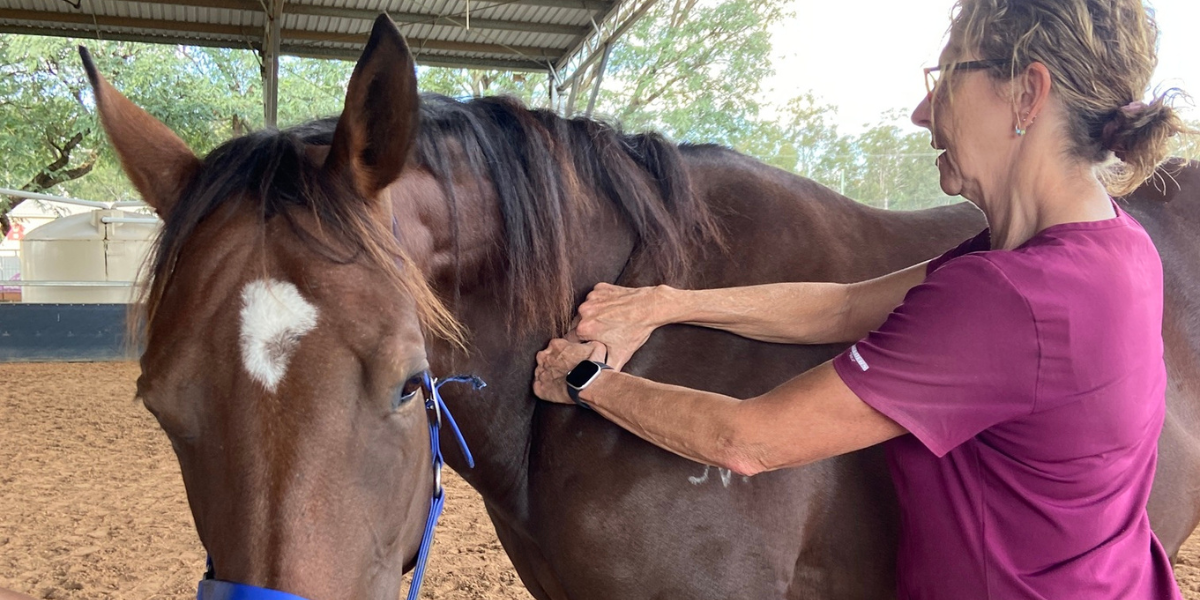What is animal physiotherapy?
Physiotherapy is not only for people! Physiotherapy also offers viable rehabilitation and treatment for animals, to improve their quality of life and prevent injuries.
Animal physiotherapists often work with veterinary surgeons in the treatment of animals. Animal physiotherapists work in musculoskeletal, sports and exercise, and aquatic physiotherapy, and help reduce pain in animals, improve their mobility and prevent recurrence of injury. They predominantly work with horses, dogs and cats; either with the beloved family pet, cattle, native or working animals, such as race horses, show jumpers, and greyhounds.
In Australia, there are several paraprofessionals working within the animal rehabilitation sphere, as this is currently not a regulated industry within Australia. This means that the market is somewhat filled by paraprofessionals, who are not as qualified as Animal Physiotherapists. It is important to understand that the person providing physiotherapy to your animal is a registered Ahpra physiotherapist.
How strong is the research evidence for animal physiotherapy practice?
Animal physiotherapy was first practised in 1939 when Lord Luis Mountbatten asked the Royal physiotherapist, Sir Charles Strong, to treat his horses. As a profession, animal physiotherapy has continued to evolve, and the body of research for animal physiotherapy is rapidly growing. Some human rehabilitation medicine and research into pain and the effects of modalities, have relied on studies that utilise animals. Many models of surgery, including spinal surgery, use animal modelling. Much of what animal physiotherapists do, is extrapolated from human-based research.
What does Animal physiotherapy involve?
Animal physiotherapists utilise techniques such as joint mobilisation, massage, stretching and trigger point release. They also work closely with animal owners, to provide education and exercise programs that facilitate recovery and management specific conditions, including post-operative recovery. Animal physiotherapists can relieve pain, improve recovery, prevent injury and provide rehabilitation for injuries, degenerative conditions and surgeries.
Animal physiotherapists may also use dry needling, hydrotherapy, ultrasound, lasers, and splints and harnesses for mobility problems.
Why is Animal physiotherapy so important?
Although animals were purely functional for much of human existence, they now play a large part in our social and emotional well-being. Animals are no longer just used for industry, agriculture, transport and safety; for many Australians, animals have become part of their family. According to Animal Medicines Australia there are almost 29 million pets in Australia - more than the estimated human population. Three in five Australian households (almost 6 million) have a pet, while 90 per cent of Australian households have had a pet at some time. Australians reportedly spend more than $13 billion on pet-related products and services, of which 20 per cent goes on veterinary services and 11 per cent on health care products.
As the role of animals in our lives grows, so does the need for higher quality and more adaptive care, including animal physiotherapy.
Where do animal physiotherapists work?
Animal physiotherapists work in small animal and equine specialist centres, university teaching hospitals, and in private practice. It is essential that physiotherapists work closely with veterinarians, farriers, equine and canine dentists and veterinary nurses. This ensures the best outcomes for the patient.
What are the minimum requirements to practice independently as an animal physiotherapist?
A Bachelor’s degree in Physiotherapy or similar, followed by post-graduate work (either graduate diploma, masters or similar non-academic exposure to animal physiotherapy) which ensures that the physiotherapist’s scope of practice covers physiotherapy for animals.
Is there a governing body ensuring credentialing in order to practice?
The Australian Health Practitioner Regulation Agency (Ahpra) is the organisation responsible for the implementation of the National Registration and Accreditation Scheme across Australia for physiotherapists and animal physiotherapists alike.
What does the Career Pathway currently look like for animal physiotherapists?
The Career Pathway is growing, as the public and veterinarians become more educated regarding animal physiotherapy.
What are the minimum requirements to maintain practice as an animal physiotherapist?
There are two requirements to maintain practice as an animal physiotherapist. An animal physiotherapist must complete 150 hours per annum as a physiotherapist working with humans, and a minimum of 20 cpd4physios hours per annum as part of the APA requirements.
Can I practice as an animal physiotherapist under my APA professional indemnity insurance?
Yes, up to $1 million in addition to the $20 million that you are covered for as a human practitioner.
Can I expect to be paid the same as I would as a human physiotherapist?
In general, the veterinary profession does not pay equivalent to that of the medical profession. If you are working in a specialist equine/canine hospital, your salary is likely to be lower than that of human hospital salary. However, in private practice you can expect to likely be paid similar in animal practice to that of human practice.
Are there many jobs for new animal physiotherapists?
Unfortunately, there are not many position vacancies, unless you set up yourself in private practice. There are also some animal physiotherapists in Australia looking to employ people who cannot fill positions.
The market is open for more animal physiotherapists to practice - the more practicing, the more exposure the profession gains.
There are also a lot of animal owners and animals requiring treatment. It is essential that we increase the number of physiotherapists working in the profession, but support each other as we do increase this number. There are definitely too many animals and not enough physiotherapists.

